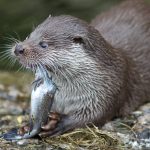Background
Despite being such a lovable carnivore, the Eurasian Otter is classified as “Near Threatened” by the IUCN due to a declining population over the last 40 years. This has steadied and the decline is not as drastic as it was over the last 23 years. The IUCN status has been described as precautionary.
Habitat
With the widest distribution of the otter subfamily, the common otter stretches from western Europe to central Asia. They also inhabit the northern most part of Africa. They live in burrow in most waterways and coastal waters.
Diet
Common otters are piscivorous, meaning they eat fish, and carnivorous. The primary component of their diet are small fishes, however they will eat whatever they can get their hands on. This includes; crabs, frogs, voles and even large water birds.
Predators & Threats
Predators include wolves, lynxes and large birds of prey.
Facts
- Otters are extremely territorial.
- Pups leave their mothers at only 1-years-old.
- They can hold their breath for around a minute.
| Common Name(s) | Scientific Name |
| Eurasian Otter, European Otter, Eurasian River Otter, Common Otter, Old World Otter | Lutra lutra |
| Size | |
| 55 - 95 cm | |
| Lifespan | |
| 18 years | |
Best Time to Look
All year round





